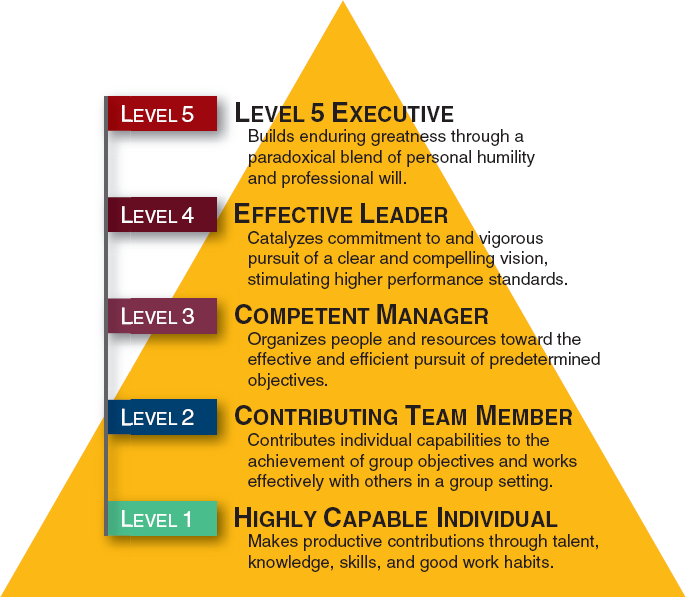"Good is the enemy of great. And that is one of the key reasons why we have so little that becomes great. We don't have great schools, principally because we have good schools. We don't have great government, principally because we have good government. Few people attain great lives, in large part because it is just so easy to settle for a good life."
-James C. Collins, Good to Great: Why Some Companies Make the Leap... and Others Don't
That captivating paragraph is what got me hooked in to reading this book. I just finished reading it for the fourth time just before writing this. In this post, I will attempt to list down key principles learned from Good to Great, and site their practical application in Steemit.

Leadership books and their practical application on Steemit is becoming a trend for me. I read books as a part of my journey to retirement. I want to make sure that when I finally leave the corporate world, my staff will be supported by a strong leadership. So I try to learn as much as I can quickly, and share what I learn in turn just as fast. In Steemit I've found another use for things I learned. I am sharing ideas from leadership books, and their practical application in this platform.
Here are a couple of my posts with the same intent:
🎯 Five Elements of Effective Thinking & Steemit
🎯 Happiness Chemicals and Steemians' Evolution


He received his bachelor's degree and MBA from Sandford. He's done consultancy work for McKinsey & Company, and did product management work for Hewlett-Packard. As a writter, he is well known for co-authoring six research based books, with "Built to Last" and "Good to Great" being the most adapted in business and leadership.
"Good to Great: Why Some Companies Make the Leap... and Others Don't" is a result of painstaking reasearch involving 6,000 articles, 2,000 pages of interview transcripts, 384 megabytes of computer data from 40 years performance of 1,435 good companies. All done, sorted, and debated on by several dozen researchers over a period of 5 years with a single objective; find companies that managed a transition from good to great, and sustained results over decades. The research team and the authors found 11 companies that made the leap, then discussed seven critical characteristics that made that leap possible.
- Level 5 Leadership
- First Who, Then What
- Confront the Brutal Facts
- Hedgehog Concept
- Culture of Discipline
- Technology Accelerators
- The Flywheel
I will expound on each of these characteristics and their practical application in Steemit.

Level 5 Leadership

We have many leaders in Steemit. Here is a comparison to the picture above by level:
Talented Individuals - They contribute greatly to the platform by producing quality content in many different areas; art, poetry, fiction, education, agriculture, engineering, sciences, travel, and many many more. They mostly work on their own and are focused on their individual contribution.
Team Players - They search, join and contribute to like-minded communities within the platform.
Group/Community Leaders - These are administrators and moderators of communities. They provide guidance to newer Steemians within their span, they drive contribution from other members, and ensure that the objectives of the community are prioritized.
Whales - They are highly committed to platform and the community. They are our inspiration, our motivators, our idols. They initiate, support, and see projects through. They are crazy about growing the community further, and are investing their hard-earned money, time, and energy towards that cause.
Big Blue Whales - These are whales who understand that this community is not about them. They are big and influential, but they act and behave like they do not know that. To them everybody contributes, thus need to be rewarded. They are humble, and yet rigorous. They are determined and ambitious, not for themselves, but for all of us.

First Who, Then What

"Most people assume that great bus drivers (read: business leaders) immediately start the journey by announcing to the people on the bus where they’re going—by setting a new direction or by articulating a fresh corporate vision."
"In fact, leaders of companies that go from good to great start not with “where” but with “who.” They start by getting the right people on the bus, the wrong people off the bus, and the right people in the right seats. And they stick with that discipline—first the people, then the direction—no matter how dire the circumstances." - Quoted from the book
In my almost three months in Steemit I haven't come across anyone who's been very successful without engaging the community. It is important to know what you will be known for in Steemit, but what's more important is knowing who will know you for what.
If everybody starts upvoting nobody but themselves, the growth rate will be evenly distributed, and the minnows will be at a clear disadvantage. The journey will be less enjoyable then, and the likelihood of organic growth low. This is why engagement is important, but engage with who?
The answer to this can vary greatly, and because I am still new, I may not have figured this out yet. This is what I am doing though:
- Engage in communities based on proximity. If you are a Filipino or an Expat living in the Philippines join us in Steemit Philippines Discord channel. We are a growing community who support each other.
- Engage in communities that share your goals and visions. I recently joined @qurator. I believe in what they are trying to do. They want to form a curation group exclusive to deserving authors by filtering member sign up. This puts a twist to the typical vote buying services. Check @qurator and join if it will stir interest.
- Engage with individuals and groups who can support your growth. We are lucky to have Terry in this country for that. He is working really hard to support Steemians from other developing countries too.

Confront the Brutal Facts

- There are many things you still need to learn.
- You probably will not earn much. Not because of anything, but due to the likelihood that not a lot of people know you yet.
- You need to continue improving yourself as you grow - the moment to start thinking you're great, you'd learn the hard way that you're not.

Hedgehog Concept

Without knowing yourself though, you will have great difficulties finding your niche, and that can cause significant delay in your growth. Applying this principle in Steemit means:
- Posting contents that are great because you have deep interest in the subject.
- Posting contents the give you joy and are really passionate about.
- Posting contents that the community will appreciate.

Culture of Discipline

Like Warren Buffet one time said: "It takes 20 years to build a reputation and five minutes to ruin it. If you think about that, you'll do things differently." So no matter how tempting it may be to game the system, focus on improving your creative side and stay away from the many temptations. There are plenty of materials about how not to behave in Steemit so I will not expound further.

Technology Accelerators

For a more comprehensive discussion on tools i will refer you to this post by @steem-buzz:
The Best 10 Steemit Tools You Can Use to Grow Faster
| Tool | URL | Use |
|---|---|---|
| SteemD | Link | Account Information & Activities |
| SteemNow | Link | Voting Power, Weight & Value |

The Flywheel

"Pushing with great effort, you get the flywheel to inch forward, moving almost imperceptibly at first. You keep pushing and, after two or three hours of persistent effort, you get the flywheel to complete one entire turn."
"You keep pushing, and the flywheel begins to move a bit faster, and with continued great effort, you move it around a second rotation. You keep pushing in a consistent direction. Three turns ... four ... five ... six ... the flywheel builds up speed ... seven ... eight ... you keep pushing ... nine ... ten ... it builds momentum ... eleven ... twelve ... moving faster with each turn … twenty … thirty … fifty … a hundred."
"Then, at some point—breakthrough! The momentum of the thing kicks in your favor, hurling the flywheel forward, turn after turn ... whoosh! ... its own heavy weight working for you. You're pushing no harder than during the first rotation, but the flywheel goes faster and faster. Each turn of the flywheel builds upon work done earlier, compounding your investment of effort. A thousand times faster, then ten thousand, then a hundred thousand. The huge heavy disk flies forward, with almost unstoppable momentum." - Quoted from the book
I agree that the fist important rule in Steemit is not to lose your password, the next important thing is to not quit. It can get quite frustrating in the beginning when you are not getting much upvotes I know, but even the most successful Steemians of today started that way. Like in the flywheel comparison in the book though, the first few pushes are the most difficult. Steem on, build the momentum, and keep at it until you breakthrough.
Here is a really nice post I came across on this topic:
MOTIVATIONAL MONDAY: Reasons Why I should Not Quit Writing Even If I'm Only Earning A Few Cents To A Dollar by @iamrosallie
Photo Credits:
Cover Photo Background
Jim Collins' Photo
Level 5 Leader Info-graphic
First Who, Then What Quote
Stockdale Paradox Quote
Hedgehog Concept Info-graphic
Writing Discipline Meme
Steem Tools by @jaycobbell
Flywheel Photo
References:
Good to Great: Why Some Companies Make the Leap...And Others Don't by Jim Collins

